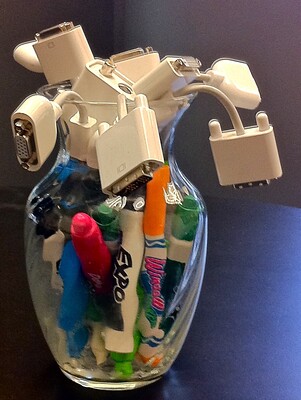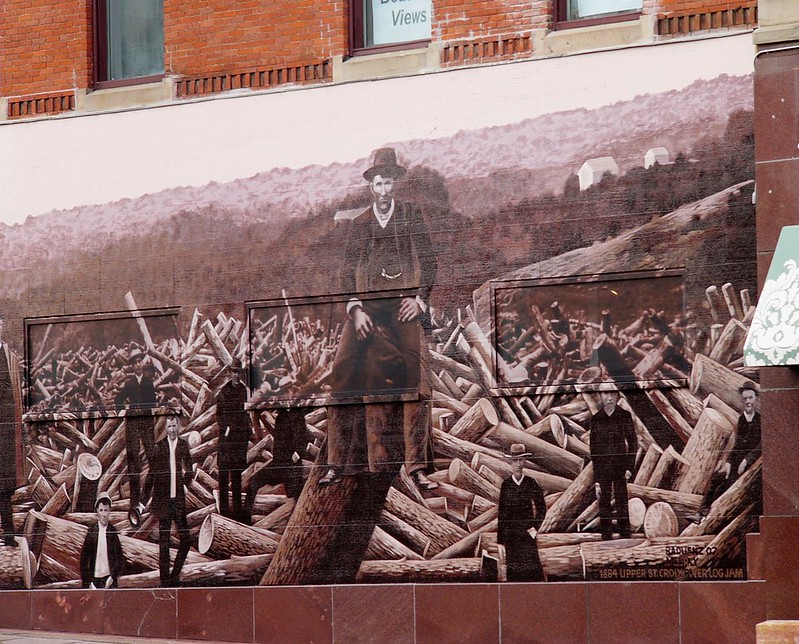Archive for the ‘Problems’ Category
You are defined by the problems you solve.
 You can solve problems that reduce the material costs of your products.
You can solve problems that reduce the material costs of your products.
You can solve problems that reduce the number of people that work at your company.
You can solve problems that save your company money.
You can solve problems that help your customers make progress.
You can solve problems that make it easier for your customers to buy from you.
You can solve too many small problems and too few big problems.
You can solve problems that ripple profits through your whole organization.
You can solve local problems.
You can solve problems that obsolete your best products.
You can solve problems that extend and defend your existing products.
You can solve problems that spawn new businesses.
You can solve the wrong problems.
You can solve problems before their time or after it is too late.
You can solve problems that change your company or block it from change.
You are defined by the problems you solve. So, which type of problems do you solve and how do you feel about that?
Image credit – Maureen Barlin
The Ins and Outs of Problems
 When there’s a disagreement, listen before you talk. And if that doesn’t work, listen more. With this approach, disagreement cannot blossom into a problem.
When there’s a disagreement, listen before you talk. And if that doesn’t work, listen more. With this approach, disagreement cannot blossom into a problem.
When there’s a decision to be made, make it. There are problems with any decision you make, and you might as well learn them as soon as you can.
When there’s a change coming, get people together and talk about what’s coming. One thing to remember – the talking you do before the change is much more meaningful than the talking after the change causes problems.
When an important project is behind schedule, pause the project. Nothing causes dialog, problem-solving, and movement of resources like pausing an important project.
When person A says one thing to person B and another to person C, call a meeting with A, B, and C and within fifteen minutes the source of the problem will be apparent to all.
When someone doesn’t do what they said they’d do, send them an email asking when they’ll do it. Then, at the same time every week, “reply all” to your email and ask them when they’ll do it. That way, they get to see the ever-growing, time-stamped record of their problematic non-performance.
When there’s no owner of the problem, there can be no solution. And that’s a big problem.
When it’s your problem, solve it.
When someone tries to give you their problem, don’t take it. Like any gift, if you don’t accept it, the would-be giver still owns it.
When there are no problems, there can be no learning.
Image credit — Rob Oo
Reducing Time To Market vs. Improving Profits
 X: We need to decrease the time to market for our new products.
X: We need to decrease the time to market for our new products.
Me: So, you want to decrease the time it takes to go from an idea to a commercialized product?
X: Yes.
Me: Okay. That’s pretty easy. Here’s my idea. Put some new stickers on the old product and relaunch it. If we change the stickers every month, we can relaunch the product every month. That will reduce the time to market to one month. The metrics will go through the roof and you’ll get promoted.
X: That won’t work. The customers will see right through that and we won’t sell more products and we won’t make more money.
Me: You never said anything about making more money. You said you wanted to reduce the time to market.
X: We want to make more money by reducing time to market.
Me: Hmm. So, you think reducing time to market is the best way to make more money?
X: Yes. Everyone knows that.
Me: Everyone? That’s a lot of people.
X: Are you going to help us make more money by reducing time to market?
Me: I won’t help you with both. If you had to choose between making more money and reducing time to market, which would you choose?
X: Making money, of course.
Me: Well, then why did you start this whole thing by asking me for help improving time to market?
X: I thought it was the best way to make more money.
Me: Can we agree that if we focus on making more money, we have a good chance of making more money?
X: Yes.
Me: Okay. Good. Do you agree we make more money when more customers buy more products from us?
X: Everyone knows that.
Me: Maybe not everyone, but let’s not split hairs because we’re on a roll here. Do you agree we make more money when customers pay more for our products?
X: Of course.
Me: There you have it. All we have to do is get more customers to buy more products and pay a higher price.
X: And you think that will work better than reducing time to market?
Me: Yes.
X: And you know how to do it?
Me: Sure do. We create new products that solve our customers’ most important problems.
X: That’s totally different than reducing time to market.
Me: Thankfully, yes. And far more profitable.
X: Will that also reduce the time to market?
Me: I thought you said you’d choose to make more money over reducing time to market. Why do you ask?
X: Well, my bonus is contingent on reducing time to market.
Me: Listen, if the previous new product development projects took two years, and you reduce the time to market to one and half years, there’s no way for you to decrease time to market by the end of the year to meet your year-end metrics and get your bonus.
X: So, the metrics for my bonus are wrong?
Me: Right.
X: What should I do?
Me: Let’s work together to launch products that solve important customer problems.
X: And what about my bonus?
Me: Let’s not worry about the bonus. Let’s worry about solving important customer problems, and the bonuses will take care of themselves.
Image credit — Quinn Dombrowski
X: Me: format stolen from @swardley. Thank you, Simon.
Which new product development project should we do first?
 X: Of the pool of candidate new product development projects, which project should we do first?
X: Of the pool of candidate new product development projects, which project should we do first?
Me: Let’s do the one that makes us the most money.
X: Which project will make the most money?
Me: The one where the most customers buy the new product, pay a reasonable price, and feel good doing it.
X: And which one is that?
Me: The one that solves the most significant problem.
X: Oh, I know our company’s most significant problem. Let’s solve that one.
Me: No. Customers don’t care about our problems, they only care about their problems.
X: So, you’re saying we should solve the customers’ problem?
Me: Yes.
X: Are you sure?
Me: Yes.
X: We haven’t done that in the past. Why should we do it now?
Me: Have your previous projects generated revenue that met your expectations?
X: No, they’ve delivered less than we hoped.
Me: Well, that’s because there’s no place for hope in this game.
X: What do you mean?
Me: You can’t hope they’ll buy it. You need to know the customers’ problems and solve them.
X: Are you always like this?
Me: Only when it comes to customers and their problems.
image credit: Kyle Pearce
The first step is to admit you have a problem.
 Nothing happens until the pain caused by a problem is greater than the pain of keeping things as they are.
Nothing happens until the pain caused by a problem is greater than the pain of keeping things as they are.
Problems aren’t bad for business. What’s bad for business is failing to acknowledge them.
The consternation that comes from the newly-acknowledged problem is the seed from which the solution grows.
There can be no solution until there’s a problem.
When the company doesn’t have a big problem, it has a bigger problem – complacency.
If you want to feel anxious about something, feel anxious that everything is going swimmingly.
Successful companies tolerate problems because they can.
Successful companies that tolerate their problems for too long become unsuccessful companies.
What happens to people in your company that talk about big problems? Are they celebrated, ignored, or ostracized? And what behavior does that reinforce? And how do you feel about that?
When everyone knows there’s a problem yet it goes unacknowledged, trust erodes.
And without trust, you don’t have much.
Problems, Learning, Business Models, and People
 If you know the right answer, you’re working on an old problem or you’re misapplying your experience.
If you know the right answer, you’re working on an old problem or you’re misapplying your experience.
If you are 100% sure how things will turn out, let someone else do it.
If there’s no uncertainty, there can be no learning.
If there’s no learning, your upstart competitors are gaining on you.
If you don’t know what to do, you’ve started the learning cycle.
If you add energy to your business model and it delivers less output, it’s time for a new business model.
If you wait until you’re sure you need a new business model, you waited too long.
Successful business models outlast their usefulness because they’ve been so profitable.
When there’s a project with a 95% chance to increase sales by 3%, there’s no place for a project with a 50% chance to increase sales by 100%.
When progress has slowed, maybe the informal networks have decided slower is faster.
If there’s something in the way, but you cannot figure out what it is, it might be you.
“A bouquet of wilting adapters” by rexhammock is licensed under CC BY-SA 2.0.
Is it time to break the logjam?
Clearing a logjam is not about increasing the force of the water. It’s about moving one log out of the way, watching what happens, and choosing the next log to move.
Crossing a raging river is not about pushing against the current. It’s about seeing what’s missing and using logs to build a raft.
Trekking across the tundra after crossing the raging river is not about holding onto the logs that helped you cross. It’s about seeing what’s not needed and leaving the raft by the river.
The trick is to know when to move the logs, when to use them to build a raft, and when to leave them behind.
Image credit: “Log Jam Mural _ Stillwater MN” by Kathleen Tyler Conklin is licensed under CC BY 2.0.
How To Solve Transparent Problems
 One of the best problems to solve for your customers is the problem they don’t know they have. If you can pull it off, you will create an entirely new value proposition for them and enable them to do things they cannot do today. But the problem is they can’t ask you to solve it because they don’t know they have it.
One of the best problems to solve for your customers is the problem they don’t know they have. If you can pull it off, you will create an entirely new value proposition for them and enable them to do things they cannot do today. But the problem is they can’t ask you to solve it because they don’t know they have it.
To identify problems customs can’t see, you’ve got to watch them go about their business. You’ve got to watch all aspects of their work and understand what they do and why they do it that way. And it’s their why that helps you find the transparent problems. When they tell you their why, they tell you the things they think cannot change and the things they consider fundamental constraints. Their whys tell you what they think is unchangeable. And from their perspective, they’re right. These things are unchangeable because they don’t know what’s possible with new technologies.
Once you know their unchangeable constraints, choose one to work on and turn it into a tight problem statement. Then use your best tools and methods to solve it. Once solved, you’ve got to make a functional prototype and show them in person. Without going back to them with a demonstration of a functional prototype, they won’t believe you. Remember, you did something they didn’t think was possible and changed the unchangeable.
When demonstrating the prototype to the customer, just show it in action. Don’t describe it, just show them and let them ask questions. Listen to their questions so you can see the prototype through their eyes. And to avoid leading the witness, limit yourself to questions that help you understand why they see the prototype as they do. The way they see the prototype will be different than your expectations, and that difference is called learning. And if you find yourself disagreeing with them, you’re doing it wrong.
This first prototype won’t hit the mark exactly, but it will impress the customer and it will build trust with them. And because they watched the prototype in action, they will be able to tell you how to improve it. Or better yet, with their newfound understanding of what’s possible, they might be able to see a more meaningful transparent problem that, once solved, could revolutionize their industry.
Customers know their work and you know what’s possible. And prototypes are a great way to create the future together.
“Transparent” by Rene Mensen is licensed under CC BY 2.0.
Things I Sometimes Forget
 Clean-sheet designs are fun, right up until they don’t launch.
Clean-sheet designs are fun, right up until they don’t launch.
When you feel the urge to do a clean-sheet design, go home early.
When you don’t know how to make it better, make it worse and do the opposite.
Without trying, there is no way to know if it will work.
Trying sometimes feels like dying.
But without trying, nothing changes.
Agreement is important, but only after the critical decision has been made.
When there’s 100% agreement, you waited too long to make the decision.
When it’s unclear who the customer is, ask “Whose problem will be solved?”
When the value proposition is unclear, ask ‘What problem will be solved?”
When your technology becomes mature, no one wants to believe it.
When everyone believes the technology is mature, you should have started working on the new technology four years ago.
If your projects are slow, blame your decision-making processes.
Two of the most important decisions: which projects to start and which to stop.
All the action happens at the interfaces, but that’s also where two spans of control come together and chafe.
If you want to understand your silos and why they don’t play nicely together, look at the organizational chart.
When a company starts up, the product sets the organizational structure.
Then, once a company is mature, the organizational structure constrains the product.
At the early stages of a project, there’s a lot of uncertainty.
And once the project is complete, there’s a lot of uncertainty.
“Toys Never Forget” by Alyssa L. Miller is marked with CC BY 2.0.
Problems, Solutions, and Complaints
 If you see a problem, tell someone. But, also, tell them how you’d like to improve things.
If you see a problem, tell someone. But, also, tell them how you’d like to improve things.
Once you see a problem, you have an obligation to seek a solution.
Complaining is telling someone they have a problem but stopping short of offering solutions.
To stop someone from complaining, ask them how they might make the situation better.
Problems are good when people use them as a forcing function to create new offerings.
Problems are bad when people articulate them and then go home early.
Thing is, problems aren’t good or bad. It’s our response that determines their flavor.
If it’s your problem, it can never be our solution.
Sometimes the best solution to a problem is to solve a different one.
Problem-solving is 90% problem definition and 10% getting ready to define the problem.
When people don’t look critically at the situation, there are no problems. And that’s a big problem.
Big problems require big solutions. And that’s why it’s skillful to convert big ones into smaller ones.
Solving the right problem is much more important than solving the biggest problem.
If the team thinks it’s impossible to solve the problem, redefine the problem and solve that one.
You can relabel problems as “opportunities” as long as you remember they’re still problems
When it comes to problem-solving, there is no partial credit. A problem is either solved or it isn’t.
Stop reusing old ideas and start solving new problems.
 Creating new ideas is easy. Sit down, quiet your mind, and create a list of five new ideas. There. You’ve done it. Five new ideas. It didn’t take you a long time to create them. But ideas are cheap.
Creating new ideas is easy. Sit down, quiet your mind, and create a list of five new ideas. There. You’ve done it. Five new ideas. It didn’t take you a long time to create them. But ideas are cheap.
Converting ideas into sellable products and selling them is difficult and expensive. A customer wants to buy the new product when the underlying idea that powers the new product solves an important problem for them. In that way, ideas whose solutions don’t solve important problems aren’t good ideas. And in order to convert a good idea into a winning product, dirt, rocks, and sticks (natural resources) must be converted into parts and those parts must be assembled into products. That is expensive and time-consuming and requires a factory, tools, and people that know how to make things. And then the people that know how to sell things must apply their trade. This, too, adds to the difficulty and expense of converting ideas into winning products.
The only thing more expensive than converting new ideas into winning products is reusing your tired, old ideas until your offerings run out of sizzle. While you extend and defend, your competitors convert new ideas into new value propositions that bring shame to your offering and your brand. (To be clear, most extend-and-defend programs are actually defend-and-defend programs.) And while you reuse/leverage your long-in-the-tooth ideas, start-ups create whole new technologies from scratch (new ideas on a grand scale) and pull the rug out from under you. The trouble is that the ultra-high cost of extend-and-defend is invisible in the short term. In fact, when coupled with reuse, it’s highly profitable in the moment. It takes years for the wheels to fall off the extend-and-defend bus, but make no mistake, the wheels fall off.
When you find the urge to create a laundry list of new ideas, don’t. Instead, solve new problems for your customers. And when you feel the immense pressure to extend and defend, don’t. Instead, solve new problems for your customers.
And when all that gets old, repeat as needed.
“Cave paintings” by allspice1 is licensed under CC BY-ND 2.0

 Mike Shipulski
Mike Shipulski